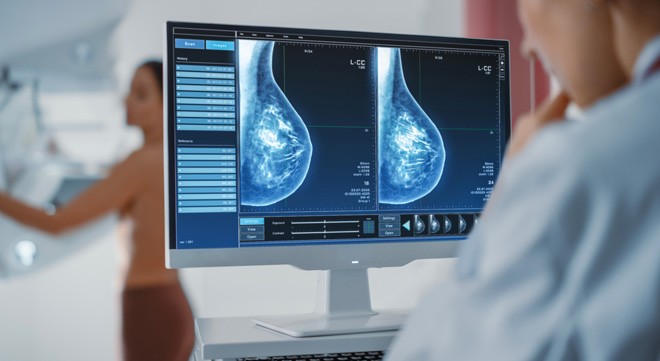Breast cancer is the most common cancer and a leading cause of death among South African women. Now consider this: 84% of South Africans depend on public healthcare for treatment. So, what does this mean for the majority of those diagnosed with cancer?
A look at any life insurer or medical scheme’s claims statistics shows that cancer remains a leading cause of claims across all demographics. Discovery Health Medical Scheme (DHMS), the scheme with the highest number of beneficiaries in the country, paid out more than R3.2 billion for cancer treatment and maintenance therapy between January and October 2023, up from R2.7bn in the same period in 2022.
Breast cancer topped claims, followed by prostate and colorectal cancers. DHMS saw the following increases in diagnoses between January and October 2023 compared to 2022: breast cancer, 2.7%; cervical cancer, 17%; prostate cancer, 8.6%; and colorectal cancer, 1.8%. Claimants ranged from the age of 17 to 98 years, highlighting cancer’s wide-reaching impact.
Read: Increase in Discovery’s cancer claim payouts – and screening rates have recovered
With only 16% of South Africans covered by medical schemes – and a small portion using both public and private healthcare – most cancer patients must rely on the public healthcare system, where many risk falling through the cracks.
Associate Professor Tasleem Ras from the University of Cape Town recently shared a real-life case study highlighting the challenges cancer patients face in accessing the public healthcare system and the immense strain on frontline healthcare providers. His presentation was part of the third African Awareness of Cancer and Early Diagnosis (AWACAN-ED) Southern Africa School for Cancer Research event, held at the UCT Graduate School of Business.
AWACAN-ED is a global health research group funded by the National Institute for Health and Care Research. It focuses on advancing early diagnosis of cancer in Southern Africa. The team comprises researchers from UCT, the University of Zimbabwe, and Queen Mary University of London in the United Kingdom.
The case study told the story of a woman in her 50s. In need of medical attention, she hitchhiked to a local clinic in Hopefield on the West Coast, believing the non-healing lesion on her left breast was an insect bite.
During a physical examination, Ras said, a healthcare worker – who had been treating the patient’s list of non-communicable diseases for years – discovered a fungating wound attached to a hard mass in her left breast. Suspecting cancer, the health worker contacted the district hospital and secured an appointment for two weeks later.
The patient was diagnosed with incurable stage four cancer and passed away in hospice care just a few weeks later. Ras noted that she died alone, as the nearest hospice facility was 37km from her home, and her family could not afford the transportation costs to visit.
“This is the African story – late presentation [of disease], lack of capacity at the clinic, [and] the referral process [between healthcare facilities] is a bit jumbled. And [when the patient eventually reached a district hospital for care] that was the last time her family saw her [alive],” Ras said. “In many ways there are certain problems here.”
The pitfalls of care
Ras divided the pitfalls for the Hopefield patient’s care into three factor categories and unpacked each of them:
- Patient factors: the patient was unaware of the lesion’s cancer risk and therefore self-assessed it incorrectly from the get-go; she had no knowledge on how to perform a self-breast examination; and when she eventually visited a healthcare facility, it was too late. The latter is often because of certain cultural beliefs and social norms.
- Healthcare worker factors: nursing practitioners provide generalist care at primary healthcare facilities; due to the high volume of patients who visit clinics, there’s little scope for individual attention; they also receive inadequate training in early cancer detection and diagnosis.
- Health system factors: a lack of cancer education exists in under-resourced communities; there’s no access to screening programmes; the referral process to an appropriate level of care facility is often delayed.
Ras said healthcare systems are very curative-focused.
“Yes, education is one of the ways to getting our clinicians to be thinking more preventative. And you can train students to think in a particular way, but when they come and work in a health system which doesn’t operate in that way, within two weeks they will be doing whatever everyone else is doing. So, we need to ensure that the curative mindset is continued into [healthcare] services,” he said.
Adopt a comprehensive approach to cancer care
He advocated for a comprehensive approach to cancer care that addresses the needs of patients at an early stage – whether newly diagnosed, in remission, or facing metastasis.
This approach, he said, should be interdisciplinary, involving a range of healthcare professionals – such as clinicians, nursing practitioners and social workers – who contribute to patient care in healthcare facilities at different stages of their journey. He said this must be implemented dynamically and coordinated, ensuring that both the patient and the family fully understand the diagnosis and the steps ahead. Additionally, he said psychosocial support should be readily available to help them navigate emotional and practical challenges of the road ahead.
Ras emphasised that comprehensive cancer care must address all dimensions of care, not just a single form, and should be dynamic to accommodate the changing needs of patients. He highlighted the importance of a healthcare system that can adapt to manage patients through survivorship and respond to recurrences or metastasis, emphasising that the system must be nimble enough to meet emerging patient needs.
“The system and the humanistic approach to how we practice must be person and relationship centred. [This patient] could’ve been your mother and that personal approach to our clinical practice, to our research, to our teaching, bring home how important this type of work is to our community,” he said.



